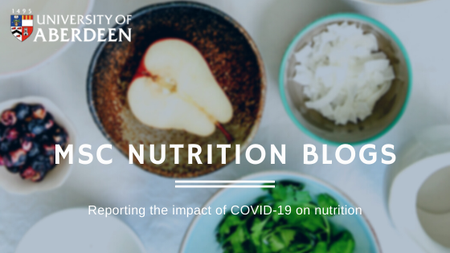By Edward Payne, Wanja Nyaga and Michael Harvey, MSc Human Nutrition students
COVID-19 joined the conversation. Toilet roll left the conversation. Dried goods and canned food flew off the shelves and, in some supermarkets, fresh produce was scarce. What instigated panic buying? Humans tend to learn from experience, and although we can learn from the swine flu, Ebola and SARS outbreaks, experience in controlling a pandemic was lacking. With no definite timescale and no previous experience, people appeared to prepare for a worst-case scenario (locked up at home, not allowed to leave, supply chains cut off). Thus, panic buying escalated.
Throughout this series of weekly blog posts we, a class of nutrition students from the University of Aberdeen, aim to share our discussions and experiences during the COVID-19 pandemic, with a focus on the global nutritional climate. We will start with a review of the initial reaction focusing on countries from which we have first-hand or good anecdotal knowledge.
Aberdeen
During the days immediately before and after the lockdown announcement, large supermarkets in Aberdeen were overwhelmed and shelves were left bare. Even the bloody spelt had vanished! Conversely, the smaller convenience stores remained well-stocked, seemingly overlooked. Despite living in an increasingly obesogenic environment, as a class, we were surprised to see some of the products that went first were items key to a nutritious diet, potentially a positive repercussion of the situation.
The response of the supermarkets has been efficient. Controlling customer numbers, distancing at checkouts and product restrictions keep shoppers safe and equally fed. Our discussion on 30/03/20 highlighted that the initial panic had subsided and that supermarkets were recovering with fresh produce coming back into stock. However, at the time of writing (05/04/20) pasta, grains and canned goods are all still absent in local supermarkets. The impact of COVID-19 on the supply chain may yet to be assessed.
Austria
Being a multicultural class has enabled us to share our insights into country-specific responses to panic buying across different regions of the world. For example, in Austria, panic buying attitudes have been similar to the UK. Items with good shelf lives such as noodles, rice and ingredient staples disappeared during the initial onset of panic buying. Yet fresh fruit and vegetables remained stable. Following the initial panic, government reassurance has helped to reduce panic buying however, small businesses seem to be fairing worse than larger retailers.
Kuwait
Moving to the Middle East, in Kuwait curfews have been introduced to restrict social spaces with higher risks of disease transmission. Curfews have also restricted evening visits out of the house but as a result this inadvertently increased traffic to shops during daytime leading to queuing and the disappearance of groceries. As a countermeasure the authorities introduced policies, so individuals only visited supermarkets within their communal zone which aided to distribute food supply more evenly. Individuals would present their ID as evidence of shopping within their zone during visits. This is currently improving the availability of stock in Kuwait’s shops gradually.
Kenya
Africa is a few weeks behind the rest of the world in terms of the spread of COVID-19. Even so, within the first week of official confirmation of cases in Kenya there was panic buying - especially for dry food commodities like rice, flour, cereals and toiletries. Most people did not buy fresh fruits and vegetables in bulk. This might be due to challenges in terms of storage. The price of sanitizers has almost tripled. There is no proper lockdown yet but there is a nationwide curfew (7pm – 5am). Most people are finding it quite limiting, especially those who are still going to work. The president also ordered the reduction of VAT from 16% to 14% which means the most valuable items are more affordable now. People working in the food industry, especially in farms and transport of produce, are exempt from the curfew allowing them to operate as usual.
Australia
In Australia, stocks of items such as toilet roll and other essentials have become less scarce in the supermarkets. Australia was one of the first countries where panic buying videos went viral on social media. Supermarkets in Australia really stepped up both collectively and at an individual level - instigating specialised hours for service workers and those in the community deemed most vulnerable. Limiting certain essential items customers can purchase at a given time has also reduced panic buying to a certain extent. Most of these supermarket instigations have been replicated or adapted in other countries to reduce panic buying.
Take-home message
Sharing the attitudes of panic buying across the world should give some reassurance that panic buying is resolvable and items will start to reappear on shelves. We have highlighted that transparency, clear guidelines, supermarket initiatives and most importantly public co-operation do work to reduce panic buying. Next week, we will be looking at the hospitality industry and how COVID-19 is affecting this sector.
Resources
- Coles. Product availability: Coles Supermarkets Australia; 2020 [cited 2020 01/04/2020]. Available from: https://www.coles.com.au/customernotice#product-availability.
- Woolworths. Stock level update: Woolworths Group Limited; 2020 [cited 2020 01/04/2020]. Available from: https://www.woolworths.com.au/shop/discover/community/stock-level-update.
- Pfundheller D. Kuwait preventative measures on Coronavirus | 10 steps to combat COVID 19. Youtube2020. p. 2:15.
Photo legend: Images provided by artists at Unsplash.com


